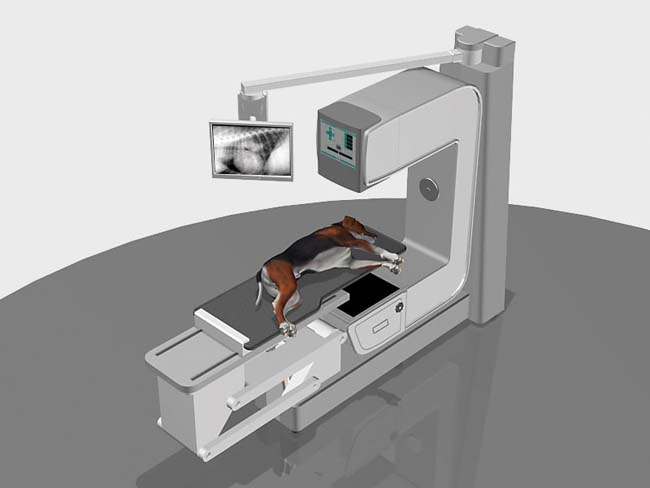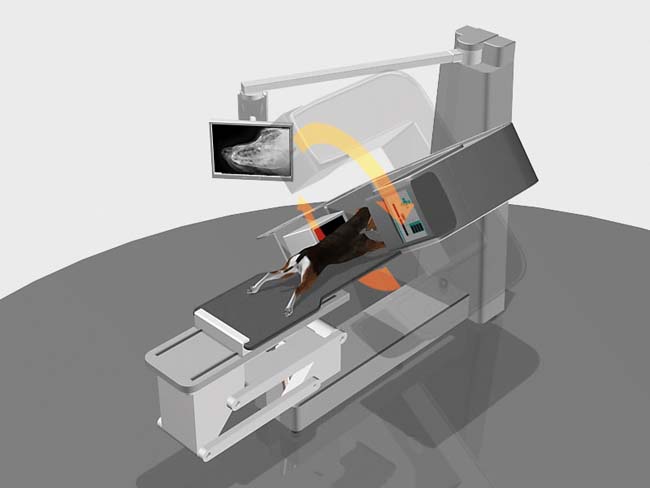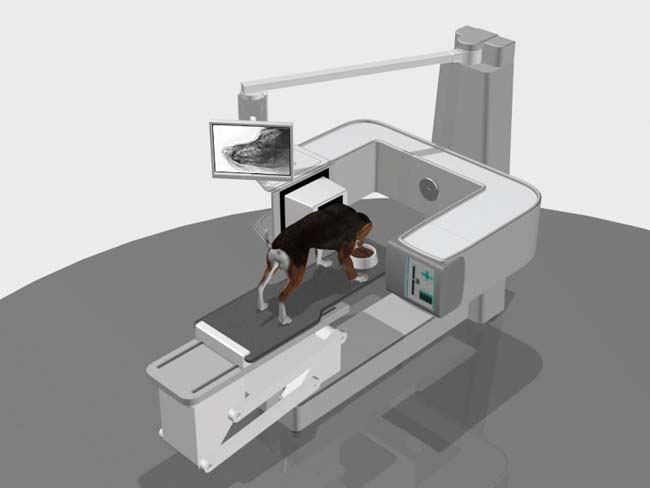Fast App: NI’s LabVIEW and CompactRIO Help Veterinary Equipment Supplier Develop Three-in-One Imaging System
The hardware and software combination enabled the rapid creation of an advanced imaging system, from prototype to final solution.
Latest News
April 26, 2010
By Matt Antonelli, Ivan Charamisinau, James Carver
Animage LLC, a subsidiary of Exxim Computing Corp., was founded in 2008 to deliver advanced imaging products to the veterinary market. With expertise in algorithm development for imaging products, such as cone-beam computed tomography (CT) scans, the company decided to expand into hardware system design and develop an unprecedented product for the veterinary market—a three-in-one imaging system called Fidex. Animage designed the multiple-modality diagnostic imaging system specifically for small animal veterinary practices.
 Figure 1. Digital radiography is often the first type of image ordered by the veterinarian. |
Fidex produces diagnostic images from three modalities, which previously required three separate devices. The first modality, digital radiography (X-rays), is often the first imaging conducted on a patient and is generally considered the workhorse of diagnostic imaging. Sometimes X-rays do not provide enough information to make a diagnosis, and more advanced techniques are needed.
The second modality uses 3D CTs, which are also known as CAT scans and are created with cone-beam technology. This is different from the standard fan-beam technology seen in human medical scanners because cone-beam CTs use a wide cone-shaped X-ray beam that acquires data in a volume via the circular rotation of the X-ray source and the detector around the subject, with a C-arm. Fidex’ implementation of cone-beam technology results in a small footprint and ease of use.
The third modality is fluoroscopy (or motion-capture X-ray video), which can be taken at any angle with the C-arm. It’s used to study joint motion, swallowing, heart function, or other physiological motion, as well as for a real-time guide for certain surgical and catheterization procedures.
Prototype Development
Phase I of the development began in April 2008, and Animage’s goal was to develop a benchtop prototype to control the X-ray source, X-ray detector, and motion system. The company developed the software gradually, beginning with the highest risk elements. Using LabVIEW, it focused on the key algorithms for the product rather than the detailed hardware design.
 Figure 2. The CT scans are conducted by rotating the C-arm around the patient and taking thousands of individual images that are then reconstructed. Fidex uses a revolutionary image reconstruction algorithm called cone-beam imaging. |
Animage began development by controlling the X-ray source. Then it created the timing code to synchronize the X-ray source generation with the sensor data acquisition. Finally, the engineers integrated the mechanical prototype with the rack-mounted generation and acquisition system and added motion control to demonstrate the basic mechanics. The functional prototype successfully demonstrated the feasibility of the product, so the company felt confident that it could successfully complete the other phases of development. The use of LabVIEW allowed for easy design modification and the replacement of several units with minimal impact on Animage’s schedule, so the engineers were able to build the first prototype in about six months.
A Preproduction Imaging System
The next phase was to develop the first preproduction imaging system. The company’s engineers finalized the mechanical design, which was based largely on the prototype mechanical system, with a few minor improvements. Animage used NI CompactRIO hardware to control a prototype scanner F-001 that included the complete X-ray system, moving gantry, and moving collimator. The engineers completed the system in three months.
 Figure 3. Moving X-ray images, or fluoroscopy, are ideal for a number of diagnostic and clinical applications, such as observing joint motion or conducting a swallowing study of a dog while it stands on the platform and eats. |
Finally, Animage needed to migrate the prototype to the final deployment technology by developing hazard-mitigation code and a rich user interface, and moving to a single-board computer designed for embedded machine development. With NI Single-Board RIO as the deployment platform, the company’s engineers implemented the same code used in the prototype system. Then they continued development and added patient positioning and the system control panel. The designers even used LabVIEW under the hood for the user interface design and completed the new system, F-002, in three months. NI Single-Board RIO controlled the end device with the following components:
- Gantry rotation with encoder and end switches
- Detector positioning with encoder and end switches
- Patient table UP/DOWN with encoders and end switches
- X-ray generator (kilovolts, milliamps, pulse generation, and error handling)
- Rotating anode
- Four collimator motors
- Detector trigger signal
- Field light and laser for patient positioning
- Gantry control panel input and status display module
Future Plans
Animage plans to build two more preproduction units and conduct clinical trials. The company expects it will have to make additional changes, but it’s also confident that it can easily add these features using LabVIEW. With LabVIEW and NI Single-Board RIO, the company’s engineers avoided having to develop most of the system from scratch, which shortened time to market and saved an estimated three work-years of development time, or about $300,000 in labor costs.
More Info
Animage LLC
Subscribe to our FREE magazine, FREE email newsletters or both!
Latest News
About the Author
DE’s editors contribute news and new product announcements to Digital Engineering.
Press releases may be sent to them via [email protected].






